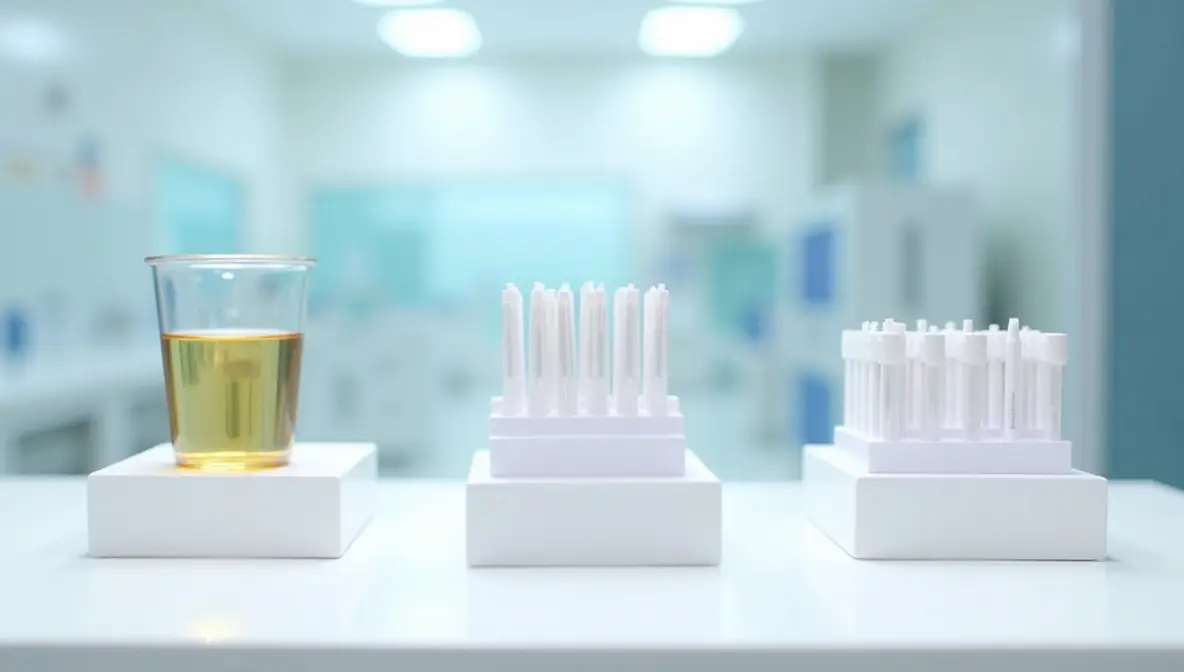Most employers select from three primary types of employment drug tests—urine (85% of companies), hair follicle (7% of companies), and saliva (8% of companies)—based on detection windows, cost considerations, and specific job requirements. Understanding these testing methods helps job seekers prepare appropriately and know what to expect during the screening process.
Key Takeaways
- Urine drug tests remain the most common employment screening method, detecting substances for 1-30 days depending on the drug and usage frequency
- Hair follicle tests provide the longest detection window at 90 days but cost significantly more than other testing methods
- Saliva tests offer rapid results within minutes but have the shortest detection period of 1-3 days for most substances
- Employers typically choose testing methods based on industry regulations, position sensitivity, and budget constraints
- Safety-sensitive positions in transportation, healthcare, and manufacturing often require more comprehensive testing protocols
- Job seekers can legally ask about testing procedures during the interview process to understand company policies
Understanding the Three Main Types of Employment Drug Tests
Employers today rely on three primary drug testing methods when screening potential hires. Each type of employment drug test offers distinct advantages and limitations. These factors influence corporate decision-making during the background check process. The choice between urine, hair, and saliva testing depends on several key factors. These include detection windows, accuracy requirements, cost considerations, and industry-specific regulations.
Drug testing has become a standard practice across industries. Over 70% of employers conduct pre-employment screenings in 2024. Understanding these testing variations helps both job seekers and employers make informed decisions. This knowledge proves valuable during the complete screening process. Companies often integrate drug testing with other background checks for comprehensive candidate evaluation.
Market Share Distribution Among Testing Methods
Current industry data reveals significant preferences in testing method selection. Urine tests dominate the employment screening landscape due to their balance of accuracy and cost-effectiveness. They also offer regulatory acceptance across most industries. Hair follicle testing serves specialized industries requiring extended detection periods. Meanwhile, saliva testing gains popularity for its convenience and rapid results.
| Testing Method | Market Share | Primary Use Cases | Average Cost Range |
| Urine | 85% | General employment, DOT compliance | $30-60 |
| Hair Follicle | 7% | Executive positions, security clearance | $100-150 |
| Saliva | 8% | Random testing, quick screening | $25-40 |
These percentages reflect current employment testing trends across various industries. The dominance of urine testing stems from established protocols and widespread laboratory infrastructure. This infrastructure supports comprehensive background checks that many employers require.
Integration with Background Check Services
Most employers combine drug testing with comprehensive background checks during the hiring process. This integrated approach provides a complete picture of candidate suitability. The screening process typically includes criminal history, employment verification, and education verification. Drug testing serves as an additional layer of safety assurance.
Many background check companies now offer bundled services that include multiple types of employment drug tests. This streamlined approach reduces administrative burden for employers. It also provides candidates with a single point of contact throughout the screening process.
Urine Drug Testing: The Industry Standard
Urine drug tests represent the gold standard for employment screening. They offer proven reliability and comprehensive substance detection capabilities. Most employers choose urine testing because it strikes an optimal balance. This balance includes detection accuracy, cost efficiency, and legal defensibility. The method can identify a wide range of controlled substances. It also provides sufficient detection windows for most employment purposes.
The testing process involves collecting a urine sample under controlled conditions. Collection typically occurs at a certified facility during the screening process. Laboratory analysis uses immunoassay screening followed by advanced confirmation testing. Gas chromatography-mass spectrometry (GC-MS) confirmation ensures high accuracy levels. These levels meet legal standards required for employment decisions.
Urine testing integrates seamlessly with other background check components. Many employers schedule drug testing alongside other screening activities. This coordination streamlines the overall background check timeline. It also reduces inconvenience for job candidates during the hiring process.
Detection Windows and Substances Covered
Urine testing offers variable detection periods depending on the specific substance. Individual usage patterns also influence detection windows. Different drugs metabolize at different rates throughout the body. This creates detection windows that range from days to weeks after last use. Understanding these timeframes helps both employers and job seekers plan appropriately.
Detection timeframes for common substances:
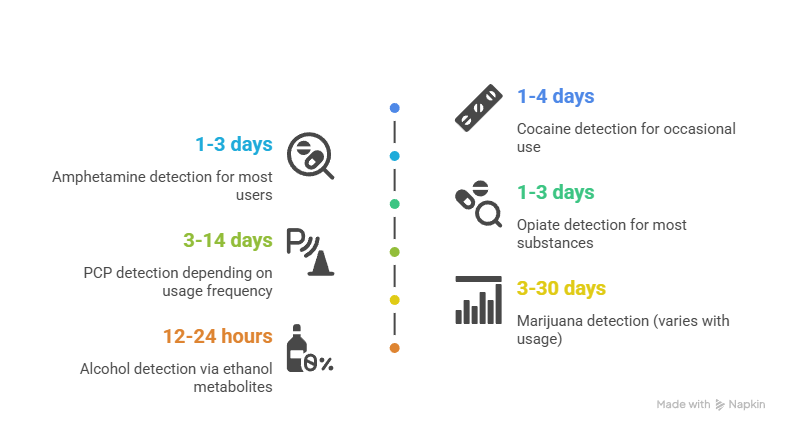
- Marijuana: 3-30 days (varies significantly with usage frequency)
- Cocaine: 1-4 days for occasional use, up to 10 days for heavy use
- Amphetamines: 1-3 days for most users, longer for chronic use
- Opiates: 1-3 days for most substances, longer for methadone
- PCP: 3-14 days depending on usage frequency
- Alcohol: 12-24 hours (when ethanol metabolites are tested)
These windows represent general ranges across different populations. Individual factors like metabolism, body mass, and hydration levels can influence detection periods. Employers typically test for the standard 5-panel or expanded 10-panel drug screens. These panels cover the most commonly abused substances in workplace settings.
Advantages for Employers and Job Seekers
Urine testing provides several benefits that explain its widespread adoption. The method offers extensive laboratory infrastructure and standardized collection procedures. Well-established legal precedents also support its use in employment decisions. These advantages make urine testing a reliable component of comprehensive background checks.
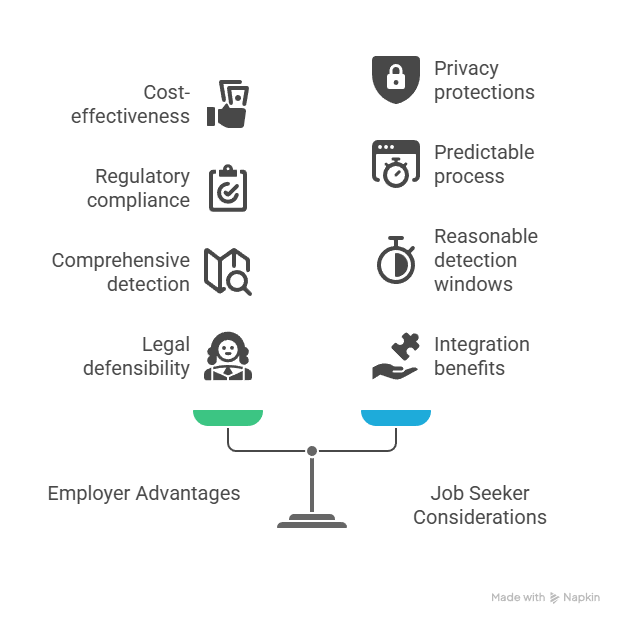
Employer advantages include:
- Cost-effectiveness: Lower per-test costs compared to hair testing methods
- Regulatory compliance: Meets DOT and other federal requirements consistently
- Comprehensive detection: Identifies multiple substance categories reliably
- Legal defensibility: Established court precedents support results in disputes
Job seeker considerations include:
- Predictable process: Standardized collection and testing procedures are well-known
- Privacy protections: Regulated collection methods protect personal dignity
- Reasonable detection windows: Allows adequate time for system clearance
- Integration benefits: Often combined with other background check elements
The established nature of urine testing means both parties understand the process. This understanding reduces uncertainty during the hiring phase. It also helps candidates prepare appropriately for the screening process.
Collection Procedures and Chain of Custody
Professional urine collection follows strict protocols to ensure sample integrity. These procedures protect both employers and job candidates throughout the testing process. Collection sites maintain detailed chain of custody documentation. This documentation tracks samples from collection through final results reporting.
The collection process begins with candidate identification verification. Collectors then explain procedures and answer questions about the testing process. Temperature strips on collection containers verify sample authenticity. Split samples may be collected for confirmation testing if initial results are positive.
Hair Follicle Drug Testing: Extended Detection Capabilities
Hair follicle drug tests provide the longest detection window among employment screening methods. These tests identify substance use up to 90 days prior to collection. This extended timeframe makes hair testing particularly valuable for certain positions. These include roles requiring enhanced security clearance or handling sensitive materials. The method analyzes drug metabolites that become incorporated into hair strands as they grow. This process creates a historical record of substance use patterns.
Employers typically reserve hair testing for executive positions and safety-sensitive roles. They also use it in situations where comprehensive screening justifies the additional cost. The 90-day detection window provides insights into patterns of substance use. This differs from isolated incidents that shorter detection windows might capture. This comprehensive view appeals to employers seeking thorough candidate evaluation through background checks.
Hair testing often serves as a premium component of executive background checks. Companies investing in comprehensive screening programs frequently include hair testing. This addition demonstrates their commitment to thorough due diligence. It also provides additional assurance for positions with significant responsibility.
Collection Process and Analysis Methods
Hair sample collection requires approximately 100-120 strands cut close to the scalp. Collectors typically take samples from the crown area of the head. If insufficient head hair exists, body hair from arms, legs, or chest can substitute. However, this substitution may extend detection windows beyond the standard 90 days. The collection process is less invasive than urine testing methods. It also eliminates concerns about sample tampering or dilution during collection.
Laboratory analysis involves washing hair samples to remove external contamination. Technicians then dissolve the hair matrix to extract embedded drug metabolites. Advanced testing methods include enzyme immunoassay screening for initial results. Liquid chromatography-tandem mass spectrometry (LC-MS/MS) provides confirmation for positive results. This two-step process ensures accuracy and legal defensibility.
Industries and Positions Most Likely to Use Hair Testing
Certain sectors demonstrate higher adoption rates for hair follicle testing. These industries have specific safety requirements, regulatory mandates, or risk management considerations. They justify the additional expense through reduced liability exposure. Enhanced workplace safety outcomes also support the investment in comprehensive testing.
High-usage industries and roles:
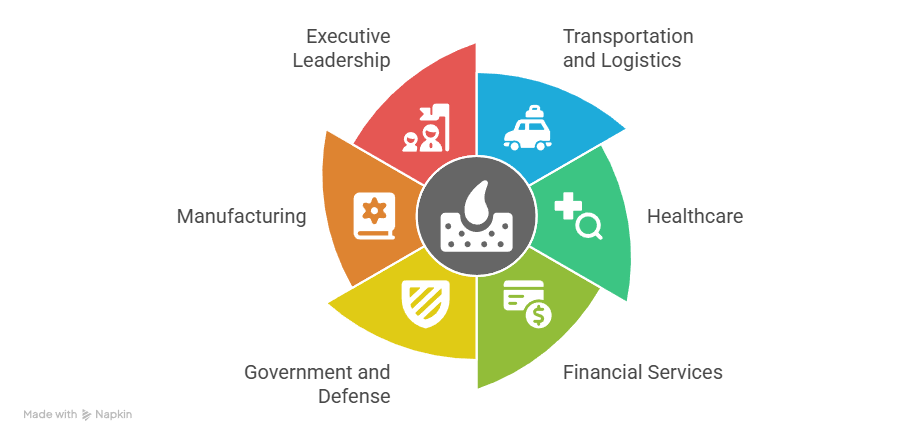
- Transportation and logistics: Commercial drivers, pilots, railroad operators requiring DOT compliance
- Healthcare: Positions with patient care responsibilities or controlled substance access
- Financial services: Roles involving significant monetary transactions or sensitive client data
- Government and defense: Security clearance positions and sensitive government installations
- Manufacturing: Safety-sensitive positions in chemical or heavy industrial settings
- Executive leadership: C-suite positions and senior management roles with fiduciary responsibilities
These applications reflect the extended detection window's value in assessing long-term behavior patterns. Companies investing in comprehensive background checks often include hair testing. This inclusion forms part of thorough candidate evaluation processes. The longer detection window provides additional confidence in hiring decisions.
Cost Considerations and ROI for Employers
Hair follicle testing represents a significant investment compared to other screening methods. However, many employers find the comprehensive detection window justifies the additional expense. The 90-day detection period provides insights that shorter-term testing cannot offer. This extended view helps employers make more informed hiring decisions.
Return on investment calculations must consider potential liability exposure and workplace safety costs. Industries with high safety requirements often find hair testing cost-effective. The comprehensive nature of hair testing can reduce turnover costs. It may also decrease workplace incidents related to substance use.
Saliva Drug Testing: Rapid Results and Recent Use Detection
Saliva drug tests excel at detecting recent substance use within the past few days. This timing typically covers 1-3 days of consumption for most substances. The method offers several operational advantages during the screening process. These include non-invasive collection, rapid processing times, and reduced opportunities for sample manipulation. Many employers use saliva testing for random screenings and post-incident investigations. It also serves as preliminary screening before more comprehensive testing methods.
The oral fluid collection process involves using specialized devices to gather saliva samples. These samples can be analyzed on-site using rapid testing equipment. Alternatively, they can be sent to laboratories for confirmation testing. Results from rapid saliva tests can be available within 10-15 minutes. However, laboratory confirmation typically takes 24-48 hours for legally defensible results.
Saliva testing integrates well with other background check components when rapid results are needed. Some employers use it as an initial screening tool. They then follow up with more comprehensive background checks for successful candidates.
Advantages and Limitations of Saliva Testing
Saliva testing provides unique benefits that make it suitable for specific employment scenarios. The method's convenience and rapid results appeal to employers needing immediate screening capabilities. The shorter detection window may benefit job seekers concerned about extended monitoring periods. However, this same characteristic can limit the test's effectiveness for comprehensive screening.
| Advantages | Limitations |
| Rapid results (10-15 minutes) | Short detection window (1-3 days) |
| Non-invasive collection process | Limited substance detection range |
| Difficult to adulterate samples | Higher per-test cost than urine |
| On-site testing capability | Less established legal precedent |
| No privacy concerns during collection | Temperature and pH sensitive |
The shorter detection window represents both an advantage and limitation. This depends on the employer's specific objectives and screening process requirements. While recent use detection suits post-incident testing, it may not identify weekend substance use. This limitation becomes apparent in Monday testing scenarios.
Optimal Use Cases for Employers
Saliva testing works best in situations requiring immediate results or frequent testing protocols. The method's convenience and rapid processing make it particularly suitable for specific workplace scenarios. Traditional testing methods often prove impractical in these situations. Saliva testing fills this gap effectively within comprehensive screening programs.
Ideal applications include:
- Post-incident testing: Immediate screening following workplace accidents or safety violations
- Random employee screening: Ongoing monitoring without advance notice to current staff
- Return-to-duty testing: Verification before allowing work resumption after violations
- Reasonable suspicion testing: Quick screening when impairment is suspected during work hours
These use cases capitalize on saliva testing's primary strengths. They also minimize the impact of its shorter detection window. Employers often combine saliva testing with other methods and background check components. This combination creates comprehensive screening programs that address multiple risk factors.
Technology and Equipment Requirements
Saliva testing requires specialized collection devices and analysis equipment. Many employers invest in on-site testing capabilities for immediate results. These systems require trained personnel to operate equipment and interpret results. Quality control procedures ensure accurate and reliable testing outcomes.
Rapid testing devices provide preliminary results that may require laboratory confirmation. This two-step process balances speed with accuracy requirements. Employers must establish procedures for handling presumptive positive results. They also need protocols for confirmation testing when required.
Factors Influencing Employer Test Selection
Employers consider multiple variables when selecting appropriate drug testing methods for their organizations. Cost considerations often drive initial decision-making throughout the screening process. However, regulatory requirements, industry standards, and specific job responsibilities ultimately determine testing protocols. Understanding these factors helps job seekers anticipate which testing methods they're likely to encounter. This knowledge proves valuable in different employment situations and background check scenarios.
Primary selection factors include:
- Regulatory compliance requirements: DOT, FDA, or industry-specific mandates that govern testing
- Position sensitivity levels: Safety-critical roles require more comprehensive testing and background checks
- Budget constraints: Cost-per-test impacts testing frequency and method selection decisions
- Detection window needs: Historical vs. recent use detection preferences based on role requirements
- Testing frequency requirements: Pre-employment, random, or post-incident testing protocols
These considerations create predictable patterns in testing method adoption. Different industries and position types show clear preferences. Companies balance thoroughness with practicality when designing drug testing programs. They also consider how testing integrates with other background check components.
Cost Analysis from Employer Perspective
Drug testing expenses extend beyond per-test costs to include administrative overhead. Legal compliance requirements and program management expenses add to total costs. Employers must evaluate total program costs when selecting testing methods. This evaluation considers both direct testing fees and indirect operational expenses throughout the screening process.
Comprehensive cost breakdown:
- Urine testing: $30-60 per test plus collection facility fees and administrative costs
- Hair follicle testing: $100-150 per test with longer processing times and specialized handling
- Saliva testing: $25-40 per test but may require additional confirmation testing
- Administrative costs: Program management, legal review, and policy development expenses
- Collection expenses: Facility fees, staff time, and candidate scheduling coordination
Volume discounts and contracted rates can significantly reduce per-test costs. Large employers often negotiate comprehensive testing agreements. These agreements include multiple testing methods at reduced rates. They may also bundle drug testing with other background check services.
Integration with Comprehensive Background Checks
Modern employers increasingly integrate drug testing with comprehensive background check programs. This integration provides a complete picture of candidate suitability. The screening process becomes more efficient when multiple checks occur simultaneously. Coordination also reduces inconvenience for job candidates throughout the hiring process.
Background check companies now offer integrated services that include drug testing options. These services streamline the screening process for employers. They also provide candidates with unified communication throughout background checks. This approach improves the overall candidate experience while maintaining thoroughness.
Industry-Specific Testing Requirements and Trends
Different industries demonstrate distinct preferences for employment drug testing methods. These preferences stem from regulatory requirements, safety considerations, and operational needs. Federal regulations mandate specific testing protocols for certain sectors. Others adopt testing based on insurance requirements or corporate risk management policies. Understanding industry-specific trends helps job seekers prepare for expected testing procedures. This knowledge proves valuable when targeting employment in specific sectors.
Transportation industries face the most stringent testing requirements. Department of Transportation (DOT) regulations drive these requirements. Healthcare, manufacturing, and government sectors also maintain comprehensive testing programs. These programs address safety-sensitive work environments and regulatory oversight. Many integrate drug testing with extensive background check requirements.
DOT-Regulated Industries and Testing Mandates
Department of Transportation regulations require specific testing protocols for safety-sensitive positions. These mandates apply across multiple transportation sectors. The regulations establish minimum testing requirements while allowing employers to implement more comprehensive programs. DOT testing often integrates with other federally mandated background check requirements.
DOT-regulated sectors and requirements:
- Commercial trucking: CDL holders must complete pre-employment, random, post-accident, and return-to-duty testing
- Aviation: Pilots, flight attendants, and maintenance personnel face comprehensive testing and background check requirements
- Railroad: Engineers, conductors, and signal operators must comply with FRA testing protocols
- Maritime: Coast Guard regulations cover commercial vessel operations and crew certification
- Public transit: Bus drivers and rail operators must meet FTA testing and screening requirements
These regulations typically specify urine testing as the primary method. Some sectors allow hair testing as an additional screening tool. Compliance failures can result in significant penalties and loss of operating licenses. They may also affect background check clearances required for continued employment.
Healthcare and Financial Services Considerations
Healthcare and financial services industries implement drug testing programs for risk management. These programs protect patients, clients, and sensitive information from potential harm. While not federally mandated like DOT testing, these sectors face significant liability exposure. This exposure drives comprehensive screening adoption that includes both drug testing and background checks.
Healthcare organizations must protect patient safety while maintaining professional standards. They also need to comply with various regulatory requirements. Financial institutions focus on protecting client assets and maintaining public trust. They achieve this through thorough employee screening processes that combine multiple verification methods.
Healthcare industry testing considerations:
- Patient safety: Direct patient care roles require comprehensive screening
- Controlled substances: Access to medications necessitates thorough background checks
- Professional licensing: State boards may require drug testing for license maintenance
- Liability exposure: Patient harm incidents can result in significant legal consequences
Financial services screening requirements:
- Client trust: Financial advisors and account managers undergo extensive background checks
- Regulatory compliance: FINRA and other agencies require comprehensive screening programs
- Fraud prevention: Access to client funds necessitates thorough candidate evaluation
- Security clearances: Government contracting roles may require enhanced screening protocols
Technology and Manufacturing Sector Trends
Technology and manufacturing sectors show increasing adoption of comprehensive screening programs. These industries recognize the importance of protecting intellectual property and maintaining workplace safety. Drug testing often forms part of broader background check requirements. Companies in these sectors balance privacy concerns with security needs.
Manufacturing environments often involve heavy machinery and hazardous materials. These conditions make drug testing a critical safety component. Technology companies may focus more on protecting sensitive information and intellectual property. Both sectors increasingly integrate drug testing with comprehensive background checks.
Legal Considerations and Employee Rights
Employment drug testing operates within a complex legal framework. This framework balances employer interests in maintaining safe workplaces with employee privacy rights. It also addresses anti-discrimination protections that apply throughout the screening process. Federal and state laws establish boundaries for testing programs. They also provide protections for both parties involved in employment relationships.
The Americans with Disabilities Act (ADA) influences drug testing policies and procedures. Various state privacy laws also affect testing programs. Collective bargaining agreements may impose additional requirements. Employers must navigate these requirements while implementing effective screening programs. These programs must support their business objectives while respecting legal boundaries.
Background check regulations often intersect with drug testing requirements. The Fair Credit Reporting Act (FCRA) may apply when third-party companies conduct testing. Employers must understand these overlapping requirements to ensure full compliance.
State Law Variations and Compliance Requirements
Drug testing laws vary significantly across states. This variation creates complex compliance requirements for multi-state employers. Some states impose strict limitations on testing procedures and background check processes. Others provide broader employer discretion in implementing screening programs. These differences require careful navigation by employers and awareness by job seekers.
Key state law variations:
- Testing method restrictions: Some states limit or regulate specific testing types and procedures
- Notification requirements: Advance notice periods for testing implementation and background check processes
- Medical marijuana protections: Varying accommodations for legal medical use under state laws
- Specimen collection standards: Regulated collection procedures and privacy protections during testing
- Result confidentiality: Strict requirements for handling and storing test results and background check information
- Wrongful termination protections: Appeals processes and reinstatement procedures for disputed results
These variations require employers to adapt their testing programs for compliance. Background check policies must also align with applicable state laws. Job seekers should research their state's specific protections and requirements. This research helps them understand their rights during the screening process.
Privacy Rights and Accommodation Requirements
Employee privacy rights extend to drug testing and background check procedures. Employers must balance their need for information with respect for candidate privacy. Reasonable accommodations may be required for certain medical conditions. These accommodations apply throughout the screening process when legally mandated.
The screening process must respect dignity and privacy while gathering necessary information. Collection procedures should minimize intrusion while ensuring sample integrity. Background check processes should focus on job-relevant information only. Employers should establish clear policies regarding information use and retention.
Preparation Strategies for Job Seekers
Understanding drug testing timelines and detection windows enables job seekers to make informed decisions. This knowledge helps with employment search planning and preparation strategies. While the most effective approach involves maintaining a drug-free lifestyle, knowledge of testing methods helps candidates understand expectations. Different testing methods require different preparation approaches based on their unique detection characteristics.
Legitimate preparation focuses on understanding testing procedures and knowing individual rights. It also involves maintaining honest communication with potential employers about testing policies. Job seekers should research company policies and industry standards. This research helps anticipate testing requirements in target employment sectors and associated background check processes.
Timeline Planning Based on Testing Method
Each drug testing method requires different preparation timelines due to varying detection windows. Understanding these timeframes helps job seekers plan their employment search effectively. It also helps avoid complications during the hiring process and screening activities.
Preparation timeline considerations:
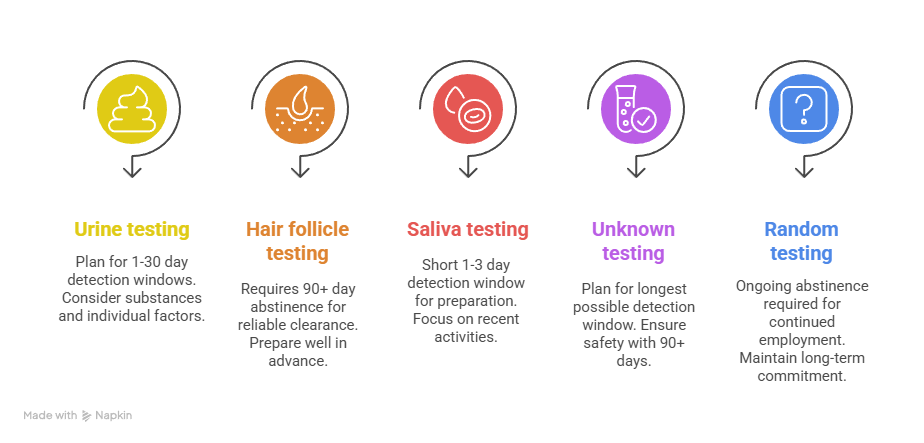
- Urine testing preparation: Plan for 1-30 day detection windows depending on substances and individual factors
- Hair follicle testing preparation: Requires 90+ day abstinence periods for reliable clearance from detection
- Saliva testing preparation: Short 1-3 day detection window allows for recent preparation activities
- Unknown testing method: Plan for longest possible detection window (90+ days) to ensure safety
- Random testing positions: Ongoing abstinence required for continued employment and career success
These timelines represent general guidelines for planning purposes. Individual factors can significantly influence detection periods and testing outcomes. Metabolism, body composition, usage frequency, and substance type all affect clearance rates. Job seekers should consider these variables when planning their employment search timeline.
Understanding False Positives and Confirmation Testing
Drug testing procedures include safeguards to minimize false positive results. However, job seekers should understand their rights when unexpected results occur. Legitimate prescription medications, over-the-counter drugs, and certain foods can potentially trigger positive screening results. These situations require additional investigation and may delay the background check process.
Common false positive triggers include:
- Prescription medications: Pain medications, ADHD treatments, and anxiety medications prescribed by doctors
- Over-the-counter drugs: Cold medicines containing pseudoephedrine or dextromethorphan
- Poppy seed consumption: Can trigger opiate positives in sensitive testing methods
- Hemp-based products: CBD products may contain trace THC amounts that cause positive results
Confirmation testing using more sophisticated analytical methods helps eliminate false positives. These tests occur before final results are reported to employers. Job seekers should maintain documentation of legitimate prescription medications. They should also discuss potential concerns with testing personnel during the screening process.
Communication with Employers and Rights Awareness
Job seekers have the right to ask about testing procedures during the interview process. This communication helps candidates understand company policies and prepare appropriately. Employers generally appreciate transparency about testing procedures and background check requirements. Open communication can prevent misunderstandings during the screening process.
Candidates should understand their rights regarding testing procedures and result confidentiality. They also have rights regarding the use of background check information. Medical Review Officers (MROs) provide opportunities to explain positive results. This explanation process protects candidates from unfair discrimination based on legitimate medical needs.
Conclusion
Employment drug testing continues evolving with technological advances and changing legal landscapes. However, urine testing remains the dominant method due to its balance of accuracy, cost, and regulatory acceptance. Job seekers benefit from understanding the different types of employment drug tests and the factors influencing employer selection decisions. Hair follicle testing provides extended detection capabilities for sensitive positions, while saliva testing offers rapid results for immediate screening needs. Success in navigating employment drug testing requires understanding industry-specific requirements, legal protections, and appropriate preparation strategies. Modern screening processes often integrate drug testing with comprehensive background checks to provide employers with complete candidate evaluation. This integration streamlines the hiring process while ensuring thorough due diligence for all parties involved.
Frequently Asked Questions
How long do different types of employment drug tests take to get results?
Urine drug test results typically take 24-48 hours for negative results and 3-5 business days if confirmation testing is required for positive screens. Hair follicle tests usually take 2-3 business days for processing, while saliva tests can provide preliminary results in 10-15 minutes with laboratory confirmation taking 24-48 hours. These timelines may extend when integrated with comprehensive background check processes.
Can employers choose which type of drug test to use, or are there restrictions?
Employers generally have discretion in selecting drug testing methods as part of their screening process, but federal regulations may mandate specific testing types for certain industries like transportation. State laws can also impose restrictions on testing methods, collection procedures, and notification requirements that employers must follow. These restrictions often apply to background check procedures as well.
Which drug test is most accurate for detecting recent drug use?
Saliva drug tests are most effective for detecting very recent drug use within 1-3 days, making them ideal for post-incident testing or reasonable suspicion screening. Urine tests provide a broader detection window of 1-30 days, while hair tests detect use over the longest period at up to 90 days. The choice depends on the employer's specific screening objectives.
Do all employers test for the same drugs, or does this vary by company?
Drug testing panels vary by employer and industry requirements, with most using either 5-panel tests (marijuana, cocaine, amphetamines, opiates, PCP) or 10-panel tests that include additional substances like benzodiazepines and barbiturates. Some employers may test for alcohol or specific drugs relevant to their industry or safety requirements. Testing panels often align with comprehensive background check policies.
What happens if I test positive on a pre-employment drug test?
Positive drug test results typically disqualify candidates from employment consideration, though some employers may allow retesting after a waiting period. Candidates have the right to provide medical explanations for positive results, such as legitimate prescription medications, through consultation with a Medical Review Officer (MRO). This process may affect the overall background check timeline.
Can I refuse to take a drug test during the hiring process?
Job applicants can refuse drug testing, but employers can withdraw job offers or eliminate candidates who decline to participate in required screening procedures. Refusal to test is generally treated the same as a positive test result for employment decision purposes. This refusal may also affect other components of the background check process.
Additional Resources
- Department of Transportation Drug and Alcohol Testing Regulations
https://www.transportation.gov/odapc - Society for Human Resource Management Drug Testing Guidelines
https://www.shrm.org/topics-tools/tools/toolkits/drug-testing - Substance Abuse and Mental Health Services Administration Testing Resources
https://www.samhsa.gov/workplace/resources - Equal Employment Opportunity Commission ADA Guidance on Drug Testing
https://www.eeoc.gov/laws/guidance - National Safety Council Workplace Drug Testing Best Practices
https://www.nsc.org/workplace/safety-topics/drugs-at-work - Fair Credit Reporting Act Compliance Guide for Employment Screening
https://www.ftc.gov/business-guidance/resources/using-consumer-reports-what-employers-need-know - Professional Background Screening Association Industry Resources
https://www.professionalbackground.org/resources
Still have questions?
Get in touch with our team today for a personalized demo and discover how our tailored volume pricing and packages can drive results for your business!
How useful was this page?*
Note: your comments are anonymous. We use them to improve the website. Do not include any personal details.
Visit our FCRA Compliance Tool or leave a message here if you need a response.
From the blog Explore the GCheck Content Hub

Prescription Drugs That Show Up on Drug Tests: A Compliance Guide
4 Dec, 2025 • 18 min read
Seasonal Employee Background Checks: Protecting Your Business During Peak Hiring Periods
4 Dec, 2025 • 22 min read
Background Check for Volunteers vs Employees: Legal Frameworks and Screening Protocol Development
3 Dec, 2025 • 14 min readThe information provided in this article is for general informational and educational purposes only and should not be construed as legal advice or a substitute for consultation with qualified legal counsel. While we strive to ensure accuracy, employment screening laws and regulations—including but not limited to the Fair Credit Reporting Act (FCRA), Equal Employment Opportunity Commission (EEOC) guidelines, state and local ban-the-box laws, industry-specific requirements, and other applicable federal, state, and local statutes—are subject to frequent changes, varying interpretations, and jurisdiction-specific applications that may affect their implementation in your organization. Employers and screening decision-makers are solely responsible for ensuring their background check policies, procedures, and practices comply with all applicable laws and regulations relevant to their specific industry, location, and circumstances. We strongly recommend consulting with qualified employment law attorneys and compliance professionals before making hiring, tenant screening, or other decisions based on background check information.
